Research Projects
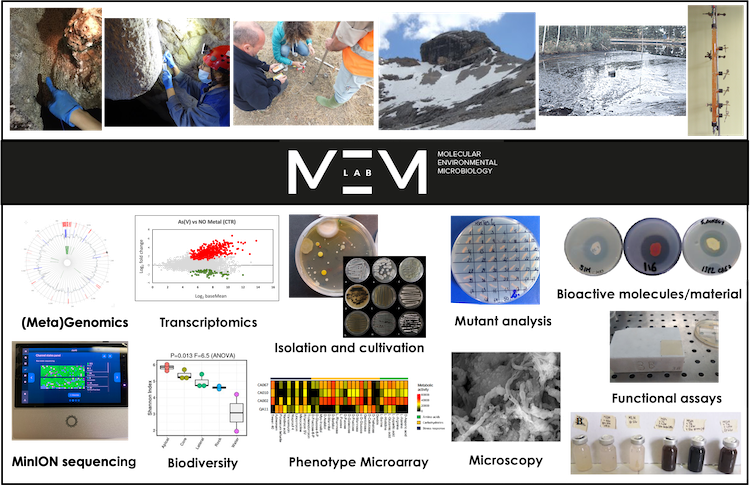
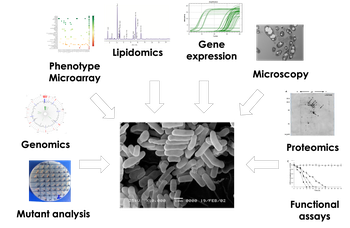
Several molecular, genomic and metabolic analyses are performed on bacteria that can degrade/convert pollutants
1. Microbial degradation and bioconversion
Microorganisms can degrade and/or transform organic and inorganic contaminants converting them into innocuous or less toxic compounds. In this project, we perform genomic, molecular and metabolic analyses of bacteria with environmental and industrial relevance, especially of the genera Rhodococcus and Pseudomonas, which are capable of metabolizing and/or biotransforming organic molecules (e.g. aliphatic and aromatic hydrocarbons) and toxic metals (e.g. arsenic and tellurite) under planktonic and biofilm growth conditions. In association with the biodegradation/biotransformation activities, we also analyze the capacity to produce high-value added products such as lipids from hydrocarbon metabolism and nanomaterials from metal transformation for possible application for biofuel generation (in the case of lipids) and for critical raw material recovery for electronics (in the case of tellurium to be used for quantum dots generation). We study gene expression analysis, gene functions and metabolic activities through omics technologies (genomics and RNA-seq), RT-PCR, random and gene-specific mutant generation, MIC analyses of planktonic and biofilm cells. We have recently been funded by PRIN 2022 for the study of the role of DNA methylation (using PacBio and MinION sequencing) on gene expression in Rhodococcus for biotechnological applications in bioremediation and biosynthesis of lipids.
Collaborations:
- Prof. Carla De Carvahlo (IBBCS, Lisbon)
- Prof. Miroslav Patek (CSACS, Prague)
- Prof. Rosa Valeria Alduina (University of Palermo)
- Dr Andrea Firrincieli (La Tuscia University)
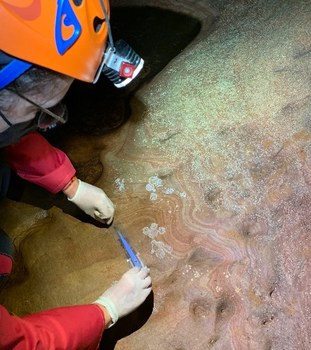
Sampling in the orthoquartzite cave Imawari Yeuta (Auyan tepui, Venezuela)
2. Microbiology of subterranean environments
Caves are subterranean ecosystems characterized by relatively stable temperature and humidity values, lack of light, and poor supply of organic nutrients. The life forms present within them have developed survival mechanisms and metabolic processes independent of light-driven photosynthesis and adapted to the scarcity and sporadic nature of organic carbon inputs. Chemotrophic microbial communities interact with the inorganic mineral rocks and typically organize themselves in complex biological formations, which are visible as biofilms, biodeposits or biospeleothems. In these environments, microorganisms contribute to the turnover of the matter and activate peculiar enzymatic reactions leading to the modification of the mineral rocks and to the production of metabolites with biotechnological potentials. In our lab, we study the mechanisms that allow the survival and growth of microorganisms in different caves (quartzite, carbonatic, sulfidic, lava caves), to get insights into the metabolic and interaction (between microbes and between microbe and rock substrate) strategies that allow microbes to colonize and thrive in these harsh environments. We apply omics (metagenomics, metatranscriptomics with Illumina and Oxford Nanopore sequencing) and bioinformatic approaches together with specific methods of microbial isolation and enrichment, bacterial mutant library construction and screening. Our study has interests in different fields spanning from environmental microbiology to astrobiology and biotechnology.
Collaborations:
- La Venta Esplorazione Geografiche (https://www.laventa.it/en)
- Miles Beyond (https://milesbeyond.it/en/extreme-locations-logistics-and-training/)
- Prof Jo de Waele's group (Speleologist and Geologist at BiGEA Dept, UNIBO)
- Federazione Speleologica Regionale dell’Emilia Romagna (F.S.R.E.R.) (https://fsrer.it/site/)
- Dr Ana Z. Miller (Geomicrobiologist, CSIC, Spain)
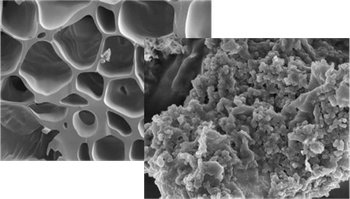
Microbial adhesion on biochar
3. Microbiology of filtering systems and biochar
Biochar is an adsorbent carbonaceous material obtained from the pyrolysis of different types of biomasses, like agricultural waste. It holds promise for low-cost remediation of contaminated waters and polluted soil as well as adsorbant for carbon sequestration. Bacteria colonize/adhere biochar in wastewater treatment plants and in polluted and agricultural soils contributing to its filtration/adsorption capacity and influencing remediation efficacy. In this project, we study the mechanisms of microbial interaction with biochar surface. Our work is aimed at investigating i) the metabolic activity, composition, and dynamics of the microbial communities colonizing biochar applied in different settings (for water and soil treatment), and ii) studying the possibility to functionalize the biochar or to recover it once it is exhausted by using synthetic microbial consortia and adapted communities. We apply omics technologies to study microbial communities and microbial isolates (metagenomics, metatranscriptomic) and selection/enrichment strategies to select bacterial strains of interest for synthetic communities. This study has interest in different fields spanning from environmental microbial to microbial biotechnology, earth science and climate change mitigation
Collaborations:
- EMRG groups, UNIBO (https://site.unibo.it/environmental-management-research-group/en) (Dr Diego Marazza, Dr Enrico Balugani, Dr Stefano Macrelli, Dr Nicolas Greggio)
- ENI Rewind
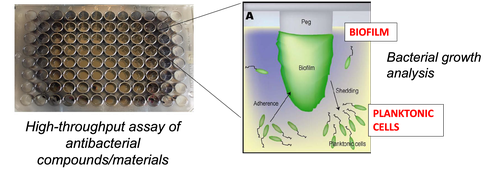
4. Antibacterial and antibiofilm activity of newly developed compounds/materials
Bacterial contamination/colonization of surfaces/materials is a challenging issue that affects many aspects of modern society and drives the search for solutions applicable to different fields including cultural heritage conservation (where bacterial colonization can lead to biodeterioration) and healthcare safety (where bacterial contamination is the cause of healthcare-associated infections). In this project, we study the antibacterial properties of specific compounds/materials that can be applied to these fields. In particular, we apply high-throughput in vitro analyses to test bioactive compounds against planktonic and biofilm cells and we test the anti-adhesion activities. We conduct both ISO standard methods and customized anti-microbial analyses (using DNA-based and microbiological approaches) to obtain information on the activity of bioactive compounds against model pathogenic bacteria and environmental strains relevant to both medical and cultural heritage applications.
Collaborations:
- Prof. Enrico Sassoni (Dept. DICAM, UNIBO)
- Dr Gabriela Graziani (Politecnico di Milano)
- Prof Cristina Chiavari (Dip. Dipartimento di Beni Culturali UNIBO), Prof. Elena Bernardi (Dip. Chimica Industriale "Toso Montanari", UNIBO), Prof. Carla Martini ( Dip. di Ingegneria Industriale, UNIBO)